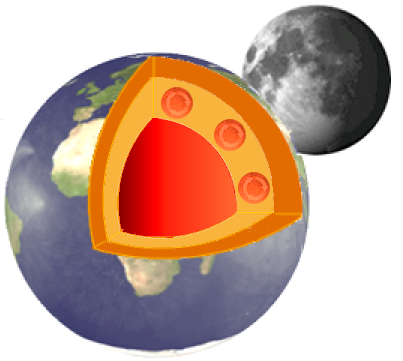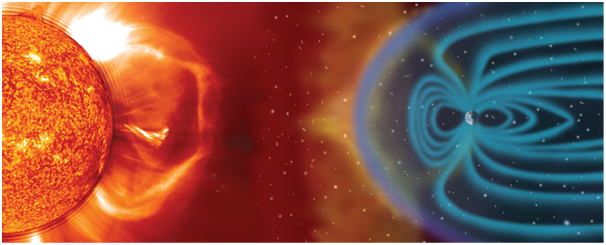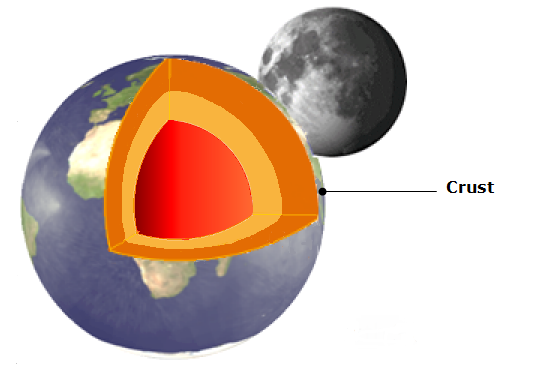Essentially the structure of the earth consists of a hard iron core which sits at the centre of a molten liquid sphere surrounded by a solid crust of rock. But there is much more to these layers each with very specific properties which are required for life on earth.
Structure of the Earth
Essentially the structure of the earth consists of a hard iron core which sits at the centre of a molten liquid sphere surrounded by a solid crust of rock. But there is much more to these layers each with very specific properties which are required for life on earth.
The Earth was formed around 4.5 billion years ago with along with the rest of our solar system (click on the link to learn how the solar system was formed) but due to impact with another planetoid shortly after (see origin of the earth) the earth reformed with a very large iron core.
For many billions of years after its formation the earth was a very hot ball of molten rock with a molten iron core but over time through many processes the earth began to cool and new layers began to form the structure of the earth as we know it today.

The Inner core
The Inner core is the deepest layer in the structure of the earth. It consists of a solid ball, mostly iron with smaller amounts of nickel, a little more than two thirds the size of our moon with a radius of 1,200 km (750 mi) (the moon has a radius of 1,737 km (1,079.6 mi).
Despite the immense heat within the inner core of the Earth, 5,000 – 7,000 ˚C (9,000 – 13,000 ˚F) the pressure of the upper-layers causes it to remain solid. This inner layer of the crust was only discovered through studying the seismic waves created by earth quakes but in studying these waves scientist found a peculiar phenomenon. Curiously seismic waves seem to pass through the earth faster when travelling north to south as opposed to east to west. Experiments on iron nickel alloys, similar to that at the inner core, suggest that it may contain giant crystals (up to 10 km in length) that would have grown in the direction of the magnetic poles. It is believed that the seismic waves travel along these crystals which would be a better material for the seismic waves to travel through then the solid core.
The Outer Core
The outer core is thicker than the inner core at around 2,300 km (1,430 miles) thick. It is a little cooler than the inner core with temperatures ranging between 4,000-5,000 ˚C (7,200 – 9,000 ˚F). Like the inner core the outer core is made from mainly iron with nickel but because the outer core is under less pressure they are in liquid form and have formed an alloy. The fact that this layer of molten metal is liquid is of great benefit to life on earth.

Image of the structure of the Earth created for earth site education ©
 The liquid metal closest to the inner core is hotter than that closer to the surface and this causes the process of convection to take place. The hotter liquid rises towards the surface and as it rises it cools. This cooler liquid alloy falls back towards the core and is then heated once more by the core.
The liquid metal closest to the inner core is hotter than that closer to the surface and this causes the process of convection to take place. The hotter liquid rises towards the surface and as it rises it cools. This cooler liquid alloy falls back towards the core and is then heated once more by the core.
It is the hot molten metal sea moving towards the surface and then sinking again in a giant whirlpool combined by the motion of the Earth’s rotation that creates the Earth’s gigantic magnetosphere which protects us from most dangerous cosmic rays and solar flares.
The image above is a computer simulation of the process which is known as the dynamo theory. New understanding of these fluid iron whirlpools are showing that the Earth doesn’t have stationary north and south magnetic poles but the poles move constantly. More alarmingly is that a part of our magnetosphere appears to be weakening and has been for some time. The phenomenon is being closely measured by scientist and they have named the phenomenon ‘the South Atlantic anomaly’. The Hubble telescope seems to be showing possible affects of this when it passes through the south Atlantic it is being bombarded by cosmic particles that are getting through the weakened magnetosphere. These particles on occasion are causing interference with the Hubble telescope and have caused a loss in communication.
It means that the movement of the core could, over 1,000-10,000 years, cause the poles to flip entirely. The gradual change may produce some very strange effects on earth such as two north or south poles simultaneously. Evidence has been found that the Earth’s poles have changed and flipped on many occasions and they will continue to do so.

The image above is of the earth’s magnetosphere in action against a solar storm.
The Mantle

Image of the structure of the Earth created for earth site education ©
The Mantle is a thick layer of magma; molten rock which is heated from the radioactivity of the core. The magma oozes and bubbles around and it is the movement of this semi-rock layer that causes earthquakes and volcanic eruptions. The temperatures range from approximately 1,900 to 2,100 ˚C (3,450 – 3,800 ˚F) and pressures can reach over 1 million times atmospheric pressure in the lower mantle. It is generally believed to be made of perovskite ((Mg, Fe) SiO3) which is a ferromagnesian silicate mineral. However new data released in 2014 suggests that the lower mantle may be made of a previously unknown material (see the lower mantle below for more information)
This is the thickest layer in the structure of the earth consisting of about 55% of the earth’s radius, at 2,900 km (1,802 mi) thick, and 85% of its total volume. The mantle can be divided into four layers.

The Lower Mantle
The hottest and most pressurised layer of the mantle with temperatures reaching 2,100˚C (3,800˚F) and pressure reaching 1.3 million times that of the earth’s atmosphere. The lower mantle is at a depth of about 650 km (400 miles) to 2,900 km (1,800 miles) below sea level. It is very hard rock which was believed to have been made of perovskite ((Mg, Fe) SiO3) which is a ferromagnesian silicate mineral. This has been brought into question by a study carried out in 2014 by a team of American scientists (led by Carnegie’s Ho-kwang Mao). After simulating the effects of the pressure and heat that the perovskite would be under in the lower mantle they have determined that it would be very unstable. They believe that the perovskite would become a different form of the mineral which would not contain the iron and would instead be a magnesium silicate perovskite ((Mg) SiO3) and this would leave a new iron rich mineral not encountered before. They named the unknown mineral H-phase and suggest that it would be hexagonal in structure.
The Upper Mantle
The Upper Mantle stretches from the continental or oceanic crust down to the lower mantle (from about 10 – 650km deep below sea level) and includes the Asthenosphere and much of the lithosphere (to the point of the Mohorovicic discontinuity). The material which makes up the upper mantle has varying consistencies dependent on the temperature and pressure the mineral is experiencing.

Image of the structure of the Earth created for earth site education.
Asthenosphere
The Asthenosphere is a section within the upper mantle between the lower mantle (2,900 km deep) and the Lithosphere (100 km deep). Between lower mantle the upper mantle (and Asthenosphere) there is a layer that is known as the transition zone. There has been a long ongoing dispute by geologists as to whether or not there is a layer of water within this transition zone. Many believed that it was not possible for water to exist this deep within the earth but new resource shows that this water does indeed exist. During the movement of plate tectonics the oceanic crust drops and it was believed that the water must have been released somehow as the olivine layer in the in the lithosphere cannot hold water. However when olivine is placed under extreme pressure – as found around 400 km deep – the atomic structure of olivine is unstable and it becomes a new form of olivine known as ‘wadsleyite’ and this is able to hold water. So theoretically if the water made it to this level then water could be transported through this layer. Further into the upper mantle – at around 500 km deep – Wadsleyite becomes Ringwoodite and this too can hold water. In fact a piece of diamond was ejected from a volcanic eruption and within this diamond was a piece of Ringwoodite and a relatively large pocket of water making the possibility of water within the transition zone much more believable. The olivine mineral which is found in the uppermost section of the asthenosphere is much more fluid than the rest of the asthenosphere and the lithosphere layer ‘floats’ upon this sea of molten rock.
Lithosphere
The lithosphere layer includes the last section of the upper mantle and the Earth’s crust. It is mainly comprised of the mineral Olivine ((Mg, Fe)2 SiO4) a magnesium-iron silicate which is an olive green coloured mineral (hence the name). It is a hard rock mineral at the bottom of the lithosphere but it weathers easily and is therefore broken down into its components by the time it reaches the outer crust (the earth’s surface). The lithosphere is a hard rock layer which rests upon the upper Asthenosphere which is a layer of molten rock and, due to the pressure of the Lithosphere layer, it has permanent plasticity.
The lithosphere is not a continuous layer of hard rock but is made up of separate pieces known as plates. This means that the hard rock of the Lithosphere is able to move around and because the oceanic and continental crusts are part of the lithosphere layer they too move. This is the mechanism by which continental drift and the formation of mountain and volcanoes occurs. The movement of these plates can also cause pressure to build as two are forced together. This pressure builds up but eventually is released in the form of earth quakes.
The Mohorovicic discontinuity
The Mohorovicic discontinuity (or ‘Moho’ as it is often known) is a layer boundary layer between the crust (oceanic and continental) and the upper mantle. It was named after its discoverer the Croatian seismologist Andrija Mohorovicic.
The Crust

Image of the structure of the Earth created for earth site education ©
The crust is not made of single sheet of rock but many sections that fit together and is the outermost layer in the structure of the earth. The sections are called plates and they look like a cracked egg shell that surrounds the globe. The fact that the crust is made up of these plates and that they ‘floats’ on the melted rock layer below is how the continents – which were once a giant landmass – have been able to move into their current positions in a process known as continental drift.

The crust can be split into two categories.
Oceanic Crust
Oceanic crust is thinner (less than 10km) than that of continental crustes however continental crust is denser and made of mafic (a mineral rich in magnesium and iron) or Basalt.
Continental Crust
The continental crust is much thicker (up to 70 km) than that of oceanic rock. The continental crust is made of the three main types of rock:-
- Igneous – cooled magma or lava
- Sedimentary – created over time from layers pressed together
- Metamorphic rock – formed from igneous or sedimentary rock that has been transformed by great heat and pressure usually from deep within the earth.


